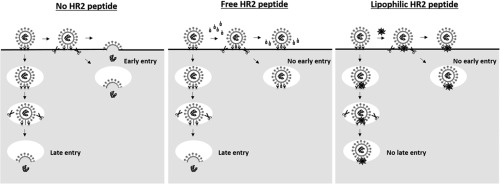Virology ( IF 2.8 ) Pub Date : 2017-08-10 , DOI: 10.1016/j.virol.2017.07.033 Jung-Eun Park , Tom Gallagher

|
Coronaviruses (CoVs) can cause life-threatening respiratory diseases. Their infectious entry requires viral spike (S) proteins, which attach to cell receptors, undergo proteolytic cleavage, and then refold in a process that catalyzes virus-cell membrane fusion. Fusion-inhibiting peptides bind to S proteins, interfere with refolding, and prevent infection. Here we conjugated fusion-inhibiting peptides to various lipids, expecting this to secure peptides onto cell membranes and thereby increase antiviral potencies. Cholesterol or palmitate adducts increased antiviral potencies up to 1000-fold. Antiviral effects were evident after S proteolytic cleavage, implying that lipid conjugates affixed the peptides at sites of protease-triggered fusion activation. Unlike lipid-free peptides, the lipopeptides suppressed CoV S protein-directed virus entry taking place within endosomes. Cell imaging revealed intracellular peptide aggregates, consistent with their endocytosis into compartments where CoV entry takes place. These findings suggest that lipidations localize antiviral peptides to protease-rich sites of CoV fusion, thereby protecting cells from diverse CoVs.
中文翻译:

脂质增加冠状病毒融合抑制肽的抗病毒活性
冠状病毒(CoV)可以导致威胁生命的呼吸系统疾病。它们的感染性进入需要病毒刺突(S)蛋白,该蛋白附着在细胞受体上,进行蛋白水解切割,然后在催化病毒-细胞膜融合的过程中重新折叠。融合抑制肽与S蛋白结合,干扰其折叠并防止感染。在这里,我们将融合抑制肽缀合到各种脂质上,期望这可以将肽固定到细胞膜上,从而增加抗病毒效力。胆固醇或棕榈酸酯加合物可将抗病毒效力提高至1000倍。蛋白水解切割后,抗病毒作用明显,这表明脂质缀合物将肽固定在蛋白酶触发的融合激活位点。与不含脂质的肽不同,脂肽抑制了CoV S蛋白定向的病毒进入内体。细胞成像显示细胞内肽聚集体,与其内吞进入进入CoV的区室一致。这些发现表明脂化作用将抗病毒肽定位于CoV融合的富含蛋白酶的位点,从而保护细胞免受多种CoV侵害。










































 京公网安备 11010802027423号
京公网安备 11010802027423号